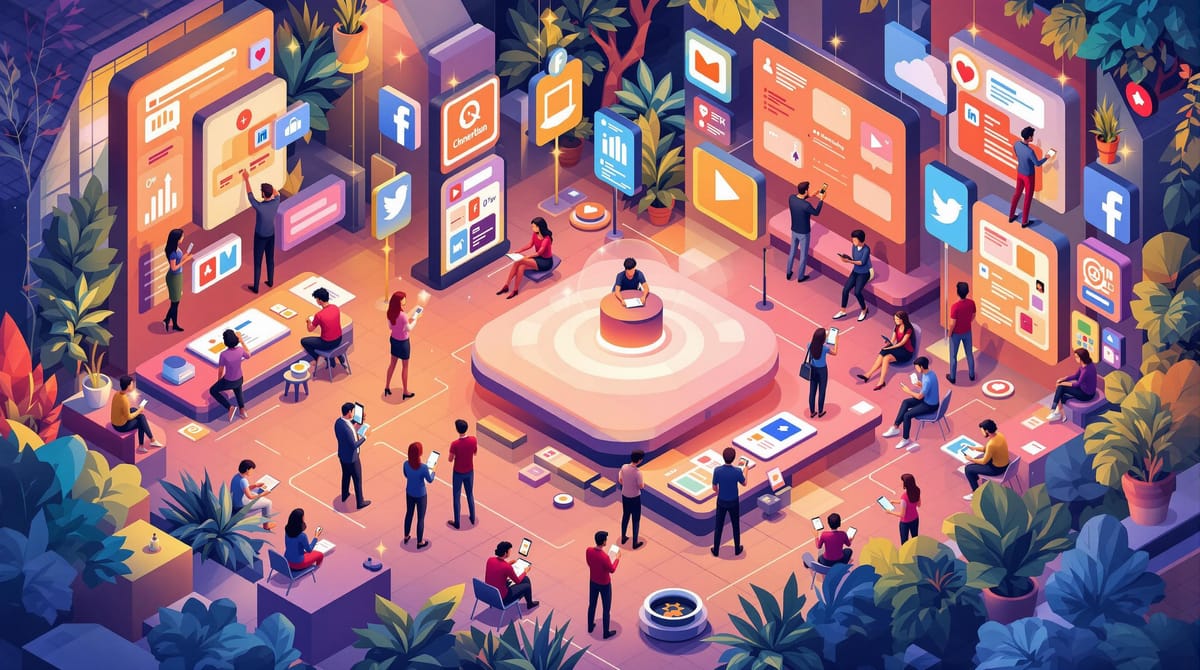7 Viral Marketing Tactics That Worked in 2025
Explore the top 7 viral marketing tactics of 2025, highlighting innovative strategies that blend technology with authentic engagement.

In 2025, viral marketing was shaped by technology, real-time engagement, and meaningful strategies. Here's a quick overview of the 7 tactics that stood out:
- Social Media Challenges: TikTok led the way with interactive campaigns, driving high participation and ROI.
- AI Content Customization: Brands used AI to deliver personalized messages, boosting engagement and lowering costs.
- AR Marketing: Augmented reality created immersive experiences, merging physical and digital worlds.
- Small-Scale Influencers: Micro- and nano-influencers achieved higher engagement at lower costs.
- Instant Response Marketing: Quick reactions to trends kept brands relevant and engaged audiences.
- Social Impact Marketing: Purpose-driven campaigns tied to meaningful causes resonated deeply with consumers.
- Live Stream Events: Real-time interaction through live video drove engagement and broke geographical barriers.
Quick Comparison Table
| Tactic | Key Feature | Impact |
|---|---|---|
| Social Media Challenges | Interactive campaigns on TikTok | High participation and ROI |
| AI Content Customization | Personalized messaging with AI | +40% engagement, -60% costs |
| AR Marketing | Immersive digital-physical blend | Improved user experience |
| Small-Scale Influencers | Micro/nano influencers | Higher engagement, lower costs |
| Instant Response Marketing | Quick reactions to trends | Real-time relevance |
| Social Impact Marketing | Purpose-driven campaigns | Strong consumer trust |
| Live Stream Events | Real-time video interaction | Broader reach and engagement |
These strategies show how brands combined technology with authentic engagement to stand out in 2025. Let's dive deeper into each tactic.
5 BRAND NEW Digital Marketing Strategies for 2025
1. Social Media Challenge Campaigns
In 2025, social media challenges became a highly effective tool for viral marketing, with 96% of marketers reporting positive results from these campaigns. The formula for success? Creating interactive, engaging content that connects with audiences while achieving measurable goals.
TikTok led the charge as the go-to platform for these challenges, with an astonishing 16,000 new videos uploaded every minute. This sheer volume meant brands needed to carefully plan their campaigns to stand out.
"TikTok challenges are still the lifeblood of the platform." – Olivia Rock, Content Manager at Youbee Media
What made these campaigns work? They were built around clear objectives, tailored content that fit each platform's quirks, and a strong emphasis on community interaction.
On average, brands spent $7,950 per month on challenge campaigns, which delivered strong returns. Adding social commerce features to these campaigns often boosted results further, contributing to the projected $2.9 trillion in social sales by 2026.
To gauge success, brands tracked key metrics like:
- Engagement Rate: Measuring likes, shares, and comments.
- Participation Rate: Monitoring hashtag usage and user submissions.
- Conversion Impact: Assessing sales and lead generation directly tied to the campaign.
- Brand Sentiment: Evaluating audience reactions and feedback.
Social listening tools also played a big role, helping brands keep tabs on audience sentiment and spot trending topics.
"The goals you have set for at the start of the year could have already changed. Depending on the shifts your organization is making, or the changing social landscape, make sure you are revisiting your goals every quarter to see if any updates need to be made." – Eileen Kwok, Social Media Specialist at Hootsuite
The biggest takeaway from these campaigns? Genuine connections with audiences and a clear strategy are what drive viral success. Regular tracking and adjustments ensured brands stayed on course and maximized their impact.
2. AI Content Customization
As social media trends evolved, brands began using AI to create highly personalized content strategies.
By 2025, 73% of businesses were using AI for content creation. This approach transformed how brands connected with audiences, delivering tailored messages on a large scale. The results? Up to 40% higher engagement, quadrupled content output, and 60% lower production costs.
"Hyper-personalization isn't just the next step in marketing - it's the expectation. In 2025, every consumer interaction will feel like a conversation tailored just for them, transforming customer loyalty from a goal into a natural outcome."
– Miroslav Jirku, Director of Product Marketing, Kentico
Nike's Personalization Wins

Nike's multi-channel personalization efforts produced impressive outcomes:
| Metric | Improvement |
|---|---|
| E-commerce conversion | +35% |
| Mobile app engagement | 3x increase |
| Ad spend waste reduction | 28% reduction |
| Customer lifetime value | +40% |
What Consumers Want
Research shows 91% of consumers prefer shopping with brands that use AI-powered personalized recommendations. This demand has driven platforms like Dreamwriter and Brand Ninja to develop advanced tools. One standout example is GroupGoLocal's use of Dreamwriter. According to founder Cristian Gallardo:
"Since starting to use Dreamwriter, I'm spending 4 hours/day and creating 3x as much content as I was. Now with Dreamwriter, I've unlocked the ability to hyper-target and localize content, which has up-leveled the relevance of my content to my end customers".
Key Success Factors
Brands succeeding with AI customization focus on these pillars:
- Data-Driven Insights: Using consumer data to predict preferences
- Automated Content Generation: Producing varied content while staying true to the brand
- Real-Time Optimization: Monitoring and adjusting content instantly
Real-World Example: Mailchimp and Spotify

Mailchimp's partnership with Spotify highlights how AI can refine email personalization. By using an Email Verification API, Spotify reduced bounce rates from 12.3% to 2.1% in just 60 days, resulting in $2.3 million in added revenue.
Balancing AI and Human Oversight
To maintain quality while scaling content, many brands combine AI tools with human review. This approach has helped 60% of marketers improve efficiency without compromising content quality.
3. AR Marketing Campaigns
AR marketing took center stage in 2025, becoming a go-to strategy for brands aiming to merge the digital and physical worlds. With the mobile AR market expected to hit $21.5 billion by 2028, companies across industries embraced this technology to create unforgettable, interactive experiences.
Major Campaign Successes
Louis Vuitton teamed up with Takashi Murakami in December 2024 for a Snapchat Lens campaign that made waves. By combining luxury branding with a playful, gamified experience, they resonated with younger audiences and set a high bar for future AR marketing efforts.
Cross-Industry Impact
AR's reach extended far beyond retail. ESPN's College Football Playoff campaign, for example, used interactive Snapchat features like motion-controlled quizzes and 3D football-themed accessories. These tools delivered engaging experiences that kept sports fans coming back for more.
"By allowing potential investors to visualize future buildings on undeveloped land, we helped our client secure a significant increase in funding. The five‐month development timeframe showcases the efficiency of our team and the power of AR technology in real estate marketing." – Andrey Kazakevich, Head of Production at HQSoftware
What Made These Campaigns Work?
The most successful AR campaigns in 2025 shared a few standout traits:
- Ease of Use: WebAR eliminated the need for app downloads, making access simple.
- Personalized Content: AI-powered tools tailored experiences in real time.
- Social Media Integration: Built-in sharing features amplified organic reach.
- Around-the-Clock Access: On-demand availability kept audiences engaged anytime.
Cultural Impact
The POLIN Museum used AR to revolutionize historical storytelling. Their AuraMajer experience brought pre-war Jewish life to platforms like Instagram and TikTok, connecting with audiences through immersive, digital narratives.
Market Growth Drivers
The U.S. led AR adoption, with the market projected to reach $10.9 billion. This growth was fueled by stronger 5G networks, better AR rendering, seamless integration with social media, and advanced tracking and analytics tools.
Overcoming Challenges
Brands tackled hurdles like technical limitations by using WebAR, addressed privacy concerns with transparent data policies, and kept costs manageable with scalable strategies. User adoption was boosted by prioritizing intuitive, easy-to-use designs.
The rise of AR marketing campaigns showed that immersive experiences are no longer optional - they're a must-have for brands looking to stand out. This trend is only set to grow, opening doors to even more creative and engaging tactics.
4. Small-Scale Influencer Partnerships
In 2025, smaller influencer collaborations became a go-to strategy, delivering targeted and budget-friendly results without relying on celebrity endorsements. Micro- and nano-influencers, known for their tightly-knit and engaged niche audiences, provided impactful outcomes at a fraction of the cost.
Engagement Metrics That Matter
Research reveals that micro-influencers often achieve up to 60% higher engagement rates compared to their larger counterparts. Nano-influencers (with fewer than 5,000 followers) boast engagement rates around 5%, highlighting the value of their close, trustworthy relationships with followers.
Cost Breakdown for Smaller Influencers
Brands found impressive value in working with smaller influencers. Here's a snapshot of typical costs for Instagram posts:
| Influencer Type | Follower Range | Cost per Post |
|---|---|---|
| Nano | 1K–10K | $10–$100 |
| Micro | 10K–50K | $110–$500 |
These partnerships often delivered an ROI of up to $20 for every dollar spent.
Why These Partnerships Succeeded
Several factors contributed to the success of small-scale influencer collaborations:
- Genuine Connections: Micro-influencers fostered meaningful interactions with their audiences, creating trust and loyalty.
- Cost Efficiency: Lower rates allowed brands to experiment with different influencers and target diverse market segments.
- Trust Factor: Around 63% of consumers said they were more likely to buy products recommended by trustworthy social media influencers.
Platform-Specific Pricing
The cost of influencer content varied across platforms, reflecting the nature of each medium:
- Instagram: Nano-influencers charged $10–$100 per post, while micro-influencers' rates ranged from $110 to $500.
- YouTube: Video creators generally asked for $20–$200 per video.
- TikTok: Short-form videos were priced between $5 and $25.
- Twitter: Quick posts cost $2–$20.
Measuring Success
Brands evaluated campaign results using metrics like engagement rates (likes, comments, shares), cost per engagement, conversion rates, customer lifetime value, and referral tracking. This data-driven approach helped marketers fine-tune their strategies, improving ROI and strengthening community ties.
Cultural Relevance
Small-scale influencers excelled at reaching niche communities with content that felt relatable and less commercialized. Their personal recommendations enhanced brand credibility and resonated with audiences looking for authentic connections. These partnerships laid the groundwork for future trends in digital marketing.
5. Instant Response Marketing
In 2025, instant response marketing became a powerful viral strategy, delivering immediate results. Success in this approach required quick action and a strong understanding of cultural trends.
Brands used social listening tools to monitor trending topics and online conversations. Two key tactics stood out:
- Social Listening: Keeping tabs on trending topics and brand mentions.
- Platform-Specific Content: Tailoring responses to fit the format and audience of each platform.
These tools enabled brands to measure the success of their responses in real time. Quick reactions often led to higher engagement, with metrics like response time and audience growth helping evaluate the campaigns.
A standout example is Oreo's famous Super Bowl blackout tweet: "You can still dunk in the dark." This clever response gained over 15,000 retweets in just minutes.
"Viral marketing is a style of promotion that relies on an audience to organically generate and push the message of a product or service." - Sprout Social
To make the most of instant response marketing, brands focused on delivering content that provided immediate value by:
- Offering quick, relevant benefits to their audience.
- Tapping into ongoing cultural trends.
- Keeping messaging consistent across all social platforms.
- Inviting audience interaction with engaging, interactive elements.
6. Social Impact Marketing
Social impact marketing made waves in 2025 as brands tied their campaigns to meaningful causes. With 76% of consumers placing more trust in purpose-driven brands, this strategy proved effective for building strong, lasting connections with customers.
Take BoxLunch, for example. Their partnership with Feeding America resulted in over 150 million meals delivered to communities in need. Tentree’s "Buy One, Plant Ten" initiative also turned heads, with a goal to plant one billion trees by 2030. These efforts highlight how transparent communication and smart use of digital platforms can lead to real, measurable results.
Key factors behind successful campaigns included:
- Clear Communication: Brands that openly shared donation details and beneficiaries earned 85% higher customer loyalty.
- Digital Channels: Campaigns that focused on digital platforms saw 87% more engagement than those relying on traditional methods.
- Influencer Content: Adding influencers to cause-related campaigns boosted fundraising by 143% compared to campaigns without them.
"We're in business to save our home planet." - Patagonia
United By Blue also gained massive attention by pledging to remove one pound of trash from oceans for every product sold. They documented their cleanup efforts, creating a compelling story that resonated with audiences.
The numbers back this up: 57% of viewers who watched nonprofit videos ended up donating. Brands that used marketing automation for cause campaigns retained 75% more donors.
What set successful campaigns apart? They focused on:
- Aligning causes with their brand values
- Crafting emotional stories that connected with their audience
- Offering easy-to-use digital donation tools
- Sharing clear, measurable outcomes
It’s worth noting that 89% of Americans aged 13–25 are willing to switch to brands that support meaningful causes. In 2022 alone, corporate giving through cause marketing hit $21 billion, marking a 13.4% growth from the previous year.
With authentic messaging and smart digital strategies, these campaigns went viral. Up next, we’ll dive into how live stream marketing events are tapping into these same digital trends.
7. Live Stream Marketing Events
Live stream events have become a game-changer for audience engagement. By 2027, the global live-streaming market is expected to reach $247 billion, with 80% of customers favoring live video over traditional blog content.
Big brands like Tesla have embraced this trend with interactive product launches that include real-time Q&A sessions. Meanwhile, fashion retailers and small businesses are using TikTok Live and YouTube Live to showcase behind-the-scenes content and demonstrate products. Many of these streams are enhanced with AI-powered chat features, making the experience even more engaging.
Patagonia, for example, has used live launches to highlight its commitment to sustainability. By sharing transparent behind-the-scenes content, the brand connects with environmentally conscious viewers in a way that aligns with its values.
To make live streams successful, brands focus on key strategies like:
- AI-driven personalization: Tailoring content based on viewer behavior.
- Interactive elements: Adding live polls, quizzes, or virtual meet-and-greets.
- Community building: Offering exclusive streams or forums for subscribers.
- Platform-specific content: Adapting the format and style to fit each streaming platform.
Web3 and decentralized platforms are also changing the game. Some brands now reward viewer participation with cryptocurrency, opening up new ways to monetize live events.
Live streaming stands out because it breaks down geographical barriers and allows for real-time interaction. Studies show that interactive features can double engagement compared to static content, proving the viral potential of this marketing approach.
Conclusion
Viral marketing in 2025 highlights the importance of blending technology, genuine connections, and engagement. Brands using AI in their viral strategies reported up to a 40% boost in engagement. Meanwhile, micro-virality and niche community focus gained popularity, with 44% of brands opting for nano-influencer collaborations.
Two standout strategies have proven especially effective:
-
Content Quality Over Quantity
A whopping 83% of marketers now prioritize quality over volume. A great example is Dove's "Real Beauty Sketches", which racked up over 65 million YouTube views by focusing on meaningful and relatable content. -
Platform-Specific Optimization
With 64% of Gen Z discovering products via social media, tailoring content to each platform is a must. Chipotle nailed this with their #ChipotleLidFlip challenge on TikTok, which hit 230 million views by aligning perfectly with the platform’s style.
"Your results are driven by how well you know your landscape and your audience."
– Sophie Miller, Founder & Director, Pretty Little Marketer
Three elements consistently define successful viral campaigns:
- Emotional Connection: Content that sparks laughter spreads 40% faster.
- Strategic Timing: Posting during peak activity and using trending hashtags boosts visibility.
- Value-First Approach: Content that entertains, educates, or solves problems wins attention.
These strategies show how brands can merge AI with genuine engagement. The growing trend of micro-influencer partnerships - adopted by 25.7% of brands - underlines the importance of targeted outreach.
Burger King's Whopper Detour campaign is a perfect example of this balance. By using creative, location-based marketing, they drove millions of app downloads, proving that viral success hinges on aligning audience interests with business goals.
Looking ahead, success in viral marketing will depend on combining tech advancements with meaningful connections, prioritizing quality content, and focusing on results that matter.





